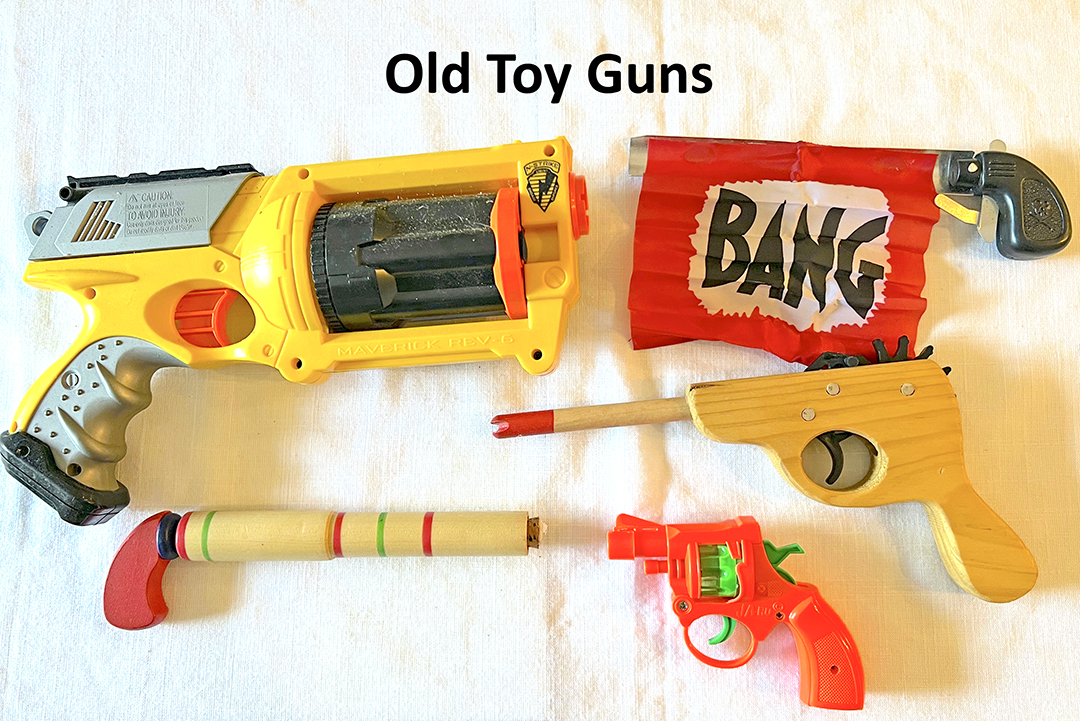REFLECTING ON GUNS AND END OF INNOCENCE

By MARJ LAW

Times have changed.
In the early to late middle 1900s, guns were part of our way of life. Children had handmade guns, pop guns, cap guns, elastic, nerf and water guns. We’d play “cops and robbers.” If we didn’t have a play gun handy, our thumbs and index fingers worked just as well.
“Bang! Bang! You’re dead!”
“No, I’m not! I shot you first!”
Guess the resolution mostly depended on the eldest person’s index finger.
On TV’s Andy Griffith Show, Don Knotts was allowed to carry only one round because he was too eager on the trigger. Back then, that was amusing.
And not so long ago, you’d see rifles hanging in the rear windows of trucks. It was legal to do so.
Kids would even take their guns to school so that they could go hunting when the final bell rang. That was OK too.
Back in the 1960s, Joe brought a long gun to school for “show and tell.” He described its parts, its history, how to care for it and how to shoot it. That was legal.
And why not?
James M. Volo, of American Military University, writes: “Most American households from colonial times were required to have a firearm (musket or rifle). It was part of the militia law of many communities.”
Laura Ingalls Wilder, writing her “Little House” books of life in the 1800s, remembers helping her father make bullets and load his rifle.
“First he melted the bits of lead in the big spoon held in the coals. When the lead was melted, he poured it carefully from the spoon into the little hole in the bullet-mold. He waited a minute, then he opened the mold, and out dropped a bright new bullet onto the hearth.
“Now he was ready to load the gun again, and Laura and Mary must help him…
“The gun was always loaded, and always above the door so that Pa could get it quickly and easily, any time he needed a gun.”
Back then, there was no question if Laura or her siblings would climb on a chair, take the gun down, and play with it.
And back then, Laura’s father depended on his gun to provide food for his family.
Times have changed.
Now it has become necessary to keep children away from firearms. Laura’s father would be taught to make sure his loaded gun was locked safely away.
And if Joe were to bring his rifle to school today, he’d be suspended.
School children cannot own guns and can certainly not bring them on a school campus anymore.
Watching Don Knotts mishandle a firearm even on a set is no longer amusing.
If you hear “Bang! Bang,” you’ll most likely listen carefully to make sure you’re hearing a child just pretending he has a gun.
Too many toy guns appear alarmingly realistic.
This is a problem because of the upswing of misuse of firearms. The age of innocence is over.
However, even though some people have harmed or killed others using firearms, our constitutional “unalienable” Bill of Rights allows American citizens (who are not felons) the ability to bear arms through the 2nd Amendment.
“Unalienable” rights are not dependent on laws or customs of a particular culture or government. They supersede governmental laws and cultural norms. “Legal” rights are those acknowledged and protected by government. “They can be changed, suspended or revoked as new laws are deemed necessary or more appropriate,” advises Legal Dictionary.
So, when some people advocate restricting certain guns or their parts, this causes a problem.
The Citizens Committee for the Right to Keep and Bear Arms (CCRKBA) blasted recent public opinion polls showing support for bans on so-called “semiautomatic weapons,” noting that constitutionally protected rights are not subject to what amounts to popularity contests.
“Fundamental rights, including the right to keep and bear arms, must never be determined by the whims of survey respondents,” said CCRKBA Chairman Alan Gottlieb. “We don’t have popularity contests to determine the rights of free speech or the press. We would hardly allow a public opinion poll to dictate whether people should worship in a church, mosque or synagogue. So, why would we think it’s allowable for a survey to tell us whether we should ban a whole class of firearms, when the 2nd Amendment has protected the rights of gun owners for more than two centuries?”
He goes on to state: “Anyone who honestly believes a survey should justify the erosion of any right guaranteed by our constitution needs a refresher course in high school civics,” Gottlieb observed. “Rights are special. We don’t need government permission to exercise them, nor do we need the blessing of a vocal minority, because in this country, citizens do not answer to the wishes of a mob.”
A. E. Samaan clarifies this: “Nowhere in the Bill of Rights are the words ‘unless inconvenient’ to be found.”
Some groups are trying to limit or ban American’s ability to own guns because some people have terribly badly misused them.
America’s age of innocence about guns is over. We are left with figuring out how to adhere to our Bill of Rights and yet keep our people safe.
On Wednesdays, when we meet others at the Wakulla County Sheriff’s Office range, gun owners work together and with newbies to learn gun safety.
The times, they are a-changing.
Marj Law is the former director of Keep Wakulla County Beautiful who has become an avid shooter in retirement.
